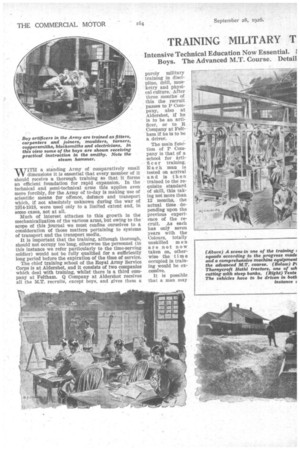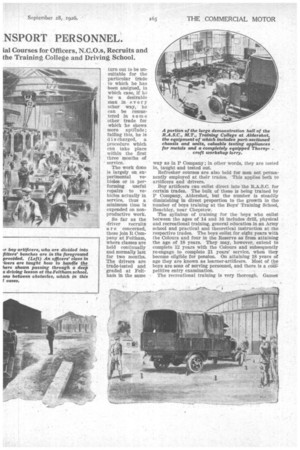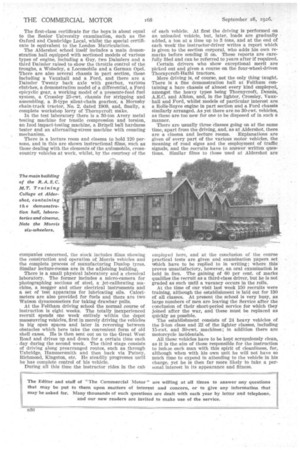TRAINING MILITARY T NSPORT PERSONNEL
Page 50

Page 51

Page 52

Page 53

Page 54

If you've noticed an error in this article please click here to report it so we can fix it.
WITH a standing Army of comparatively small dimensions it is essential that every member of it should receive a thorough training so that It forms an efficient foundation for rapid expansion. In the technical and semi-technical arms this applies even more forcibly, for the Army of to-day is making use of scientific means for offence, defence and transport which, if not absolutely unknown during the war of 1014-1918, were used only to a limited extent and, in some cases, not at all.
Much of interest attaches to this growth in the mechanicalization of the various arms, but owing to the scope of this journal we must confine ourselves to a consideration of those matters pertaining to systems of transport and the transport media.
It is important that the training, although thorough, should not occupy too long, otherwise the personnel (in this instance we refer particularly to the time-serving soldier) would not be fully qualified for a sufficiently long period before the expiration of the time of service.
The chief training school of the Royal Army Service Corps is at Aldershot, and it consists of two companies which deal with training, whilst there is a third company at Feltham. Q Company at Aldershot receives all the M.T. recruits, except boys, and gives them a purely military training in discipline, drill, musketry and physical culture. After three months of this the recruit passes to P Company, also at Aldershot, if he is to be an artificer, or to R Company at Feltham if he is to be a driver.
The main function of P Company is that of a school for arti ft training. Each man is tested on arrival and is then trained to the requisite standard of skill, this taking not more than 12 months, the actual time depending upon the previous experience of the remit. As each has only seven years with the Colours, totally unskilled m e n are not now taken on, otherwise the time occupied in training would be excessive.
It is possible that a man may turn out to be unsuitable for the particular trade to which he has been assigned, in which case, if he be a desirable man in every other way, he can be remustered in some other trade for which he shows more aptitude ; falling this, he is discharged, a procedure which can take place within the first three months of service.
The work done is largely on ex
perimental vehicles or in performing useful repairs to vehicles actually in service, thus a minimum time is expended on nonproductive work.
So far as the driver recruits are concerned, these join It Company at Feltham, where classes are held continually and normally last for two months. The drivers are trade-tested and graded at Feltham in the same way as in P Company ; in other words, they are tested in, taught and tested out.
Refresher courses are also held for men not permanently employed at their trades. This applies both to artificers and drivers.
Boy artificers can enlist direct into the R.A.S.C. for certain trades. The bulk of these is being trained by P Company, Aldershot, but the number is steadily diminishing in direct proportion to the growth in the number of boys training at the Boys Training School, Beachley, near Chepstow.
The syllabus of training for the boys who enlist between the ages of 14 and 18 Includes drill, physical and recreational training, general education in an Army school and practical and theoretical instruction at the respective trades. The boys enlist for eight years with the Colours and four in the Reserve as from attaining the age of 18 years. They may, however, extend to complete 12 years with the Colours and subsequently re-engage to complete 21 years' service, when they become eligible for pension. On attaining 18 years of age they are known as learner-artificers. Most of the boys are sons of serving personnel, and there is a coliipetitive entry examination.
The recreational training is very thorough. Games are played for one hour nearly every day in the week and the great aim is to create in the boys an esprit de corps in work and in play.
Boy artificers are classified into fitters, carpenters and joiners and moulders, with an average training time of four years ; turners, coppersmiths and blacksmiths, with three and a half years' training; and electricians, whose training occupies four and a half years ; but the time taken to pass out really depends on the boy himself. Some are not proficient until they attain the age of 19, but in nearly all cases they become learner-artificers at the age of 18. Consequently, a boy usually passes out at that age as a third-class artificer.
The training is progressive and every encouragement is given to the boy to pass on from stage to stage. Not only does he become proficient In the use of tools, but in the later stages he is employed on useful productive work in the overhauling of ears and loadcarrying vehicles and the fitting up of experimental vehicles and plant/ He is thus in a position to become acquainted with many classes of motor vehicle employed both for Army and civilian use, for there are 20 types of vehicle maintained and operated from the school, whilst vehicles for complete overhaul are sent down to Aldershot for instructional purposes from the Heavy Repair Shops at Feltham.
The learner-artificers are employed as mates to tradesmen for the first few months on entering the overhaul shop, and are then entrusted with work on their own. Reports on the progress of the boys are rendered by their instructors every three months, and in this way any slacking off of interest can be checked in time. During our visit to the school at Aldershot we examined with great interest many examples of most accurate fitting work which had been performed by these boys even in the earlier stages of their training.
A refresher course is arranged for artificer-sergeants, and this must be passed before they can be admitted to the higher rank of mechanist staff sergeant. This course occupies six months and not only provides instruction in the particular trade of the non-commis B34 sioned officer, but also gives him an insight into other trades, the idea being to raise him to the status of a leading foreman. Each N.C.O. must reach a high standard in this course to qualify for advancement.
Dealing with the training of officers, all those of the Regular Army, Supplementary Reserve and Territorial Army are posted to P Company of the R.A.S.C. Training College for a purely technical or administrative course in mechanical transport, during which they learn methods of procedure, stores duties and subjects other than those concerning mechanism.
The Territorial Army courses are of 18 clays' duration and are open to the officers and N.C.O.s. They consist of 25 lectures on subjects such as (1) mechanical transport organization for peace and war ; (2) mobilization procedure ; (3) convoy work ; (4) first-aid to transport vehicles ; culminating (5) in a transport and supply scheme in the surrounding country over an area with a radius of some 40 miles. This is performed without vehicles, and training is given in map-reading, arranging convoy tinles, etc.
The Course for the Supplementary Reserve lasts one month, of which one week is spent in learning duties of a purely military nature, whilst the remainder follows very closely the syllabus for officers of the Territorial Army. In both courses suitable time s devoted to lorry driving in convoy.
The Regular officer, following the preliminary train lag in military duties, and after courses in horsed transport and supply work, is posted to P Company for a 13-week course in the elementary principles of the automobile. The course includes much driving by day and night on all types of M.T. vehicle, together with theoretical instruction and a small amount of workshop instruction.
At the concluding examination 'officers who receive more than 80 per cent. of marks are encouraged to take a further M.T. training. This higher grade of instruction consists of a two-years' course in the engineering shops of certain well-known makers, such as 1Volseley, Crossley, Halley, Albion, Karrier, Guy, Thornyeroft and A.E.C. Concurrently with this they have to take a special course known as the A and B grades of the International Correspondence Schools. This must be dealt with during the spare time after working the usual hours in the shops. Notes regarding the work performed, processes viewed, etc., have to be rendered three times yearly to the Commandant of the Training College. This is to ensure that full use is made of the opportunities presented to them.
At the conclusion of the two years officers are reposted to Aldershot for an advanced theoretical course occupying one year, and after passing this they are regarded as qualified workshop officers and drafted to technical appointments as opportunity permits. It must be remembered that all this instruction is in addition to the special training as an officer of equal status to those of any other combatant arm of the Service. The chief reason for this is that all appointments in the Army are open to officers of the R.A.S.C. in common with their comrades of other arms, so that their general knowledge must be on the same footing. Officers on the advanced M.T. course make a yearly tour, occupying one week, of a number of works; for instance, last year they were received by the following companies :— James Booth and Co., of Birmingham, who are the makers of Vickers's duralumin ; the Staveley Coal and Iron Co., of Chesterfield; Vickers, Ltd., at their River Don Works, Sheffield ; the London, Mid land and Scottish Railway Co., at their works in Derby; Armstrong-Siddeley Motors, Ltd.; and the Coventry Chain Co., Ltd., of Coventry.
Part of the training of officers is :the driving of Holt caterpillars.
The Indian Army is now sending over a number of officers to take the M.T. course, with a view to their taking over the Me, chanical Transport in T h e senior N.C.O.s have a six weeks' course in driving, stores and accounts.
Reverting to the training of the boys,
the fitter ,boys are divided into four squads. They commence by filing squares, etc., and then progreis to making instruments, scribing blocks, vernier sliding callipers and such work as fitting keys to shafts. The.two-best boys in the senior squad each year . are -selected to go on the long 3,L.T. courses with the officers, and these eventually form a reserve •capable of highly technical work or instructing.
The first-class certificate for the boys is about equal to the Senior University examination, such as the Oxford and Cambridge Local, whilst the special certificate is equivalent to the London Matriculation.
The Aldershot school itself includes a main demonstration hall equipped with sectioned models of various types of engine, including a Guy, two Daimlers and a third Daimler raised to show the throttle control of the troughs, a Wolseley, a Locomobile and a German Opel. There are also several chassis in part section, these including a Vauxhall and a Ford, and there are a Daimler Twenty back axle with gearbox, various clutches, a demonstration model of a differential, a Ford epicyclic gear, a working model of a pressure-feed fuel system, a Crossley 25-cwt. chassis for stripping and assembling, a B-type silent-chain gearbox, a Hornsby chain-track tractor, No. 2, dated 1909, and, finally, a complete workshop lorry of Thornycroft make.
In the test laboratory there is a 30-ton Avery metal testing machine for tensile compression and torsion, aa Izod impact-tasting machine, a Brinell ball hardness tester and an alternating-stress machine with counting mechanism.
There is a lecture room and cinema to hold 120 persons, and in this are shown instructional films, such as those dealing with the elements of the automobile, crosscountry vehicles at work, whilst, by the courtesy of the companies concerned, the stock includes films showing the construction and operation of. Morris vehicles and the complete process of manufacturing Dunlop tyres. Similar lecture-rooms are in the adjoining building.
There is a small physical laboratory and a chemical laboratory. The former includes a micro-camera for photographing sections of steel, a jet-calibrating machine, a megger and other electrical instruments and a set of test apparatus for lubricating oils. Calorimeters are also provided for fuels and there are two Watson dynamometers for taking drawbar pulls.
At the Feltham driving school the normal course of instruction is eight weeks. The totally inexperienced recruit spends one week entirely within the depot manceuvring vehicles, first in merely driving the vehicles in big open spaces and later in reversing between obstacles which here take the convenient form of old shell cases. He is then sent out on to the Great West Road and drives up and down for a certain time each day during the second week. The third stage consists of driving along prearranged routes, such as through Uxbridge, Hammersmith and then back via 'Putney, Richmond, Kingston, etc. He steadily progresses until he has complete control of his vehicle.
During all this time the instructor rides in the cab of each vehicle. At first the driving is performed on an unloaded vehicle, but, later, loads are gradually added, a ton at a time up to 3 tons, and at the end of each week the instructor-driver writes a report which is given to the section corporal, who adds his own remarks before sending it on. These reports are carefully filed and can be referred to years after if required.
Certain drivers who show exceptional merit are picked out and given a course on the four-wheel-driven Thornycroft-Hathi tractors.
Mere driving is, of course, not the only thing taught There is a fine demonstration hall at Feltham containing a bare chassis of almost every kind employed, amongst the heavy types being Thornycroft, Dennis, A.E.C. and Albion, and, in the lighter, Crossley, Vauxhall and Ford, whilst models of particular interest are a Rolls-Royce engine in part section and a Ford chassis similarly arranged. As yet there are no 30-cwt. vehicles, as these are too new for one to be disposed of in such a manner.
There are usually three classes going on at the same time, apart from the driving, and, as at Aldershot, there are a cinema and lecture rooms. Explanations are given of every part of the various motor vehicles, the meaning of road signs and the employment of traffic signals, and the recruits have to answer written questions. Similar films to those used at Aldershot are employed here, and at the conclusion of the course practical tests are given and examination papers set vohich have to be replied• to in writing; where this proves unsatisfactory, however, an oral examination is held in lieu. The gaining of 60 per cent. of marks qualifies the recruit as a third-class driver, but he is not graded as such until a vacancy occurs in the rolls.
At the time of our visit last week 150 recruits were training, although the establishment is laid out for 130 of all classes. At present the school is very busy, as large numbers of men are leaving the Service after the conclusion of their short-period service for which they joined after the war, and these must be replaced as quickly as possible.
The establishment consists of 24 heavy vehicles of the 3-ton class and 22 of the lighter classes, including 15-cwt. and 30-cwt. machines; in addition there are motorcycle incidentals.
All these vehicles have to be kept scrupulously clean, as it is the aim of those responsible for the instruction to imbae each man with this spirit of cleanliness, for, although when with his own unit he will not have so much time to expend in attending to the vehicle in his charge, yet he is then far more likely to take a personal interest in its appearance and fitness.




































































































